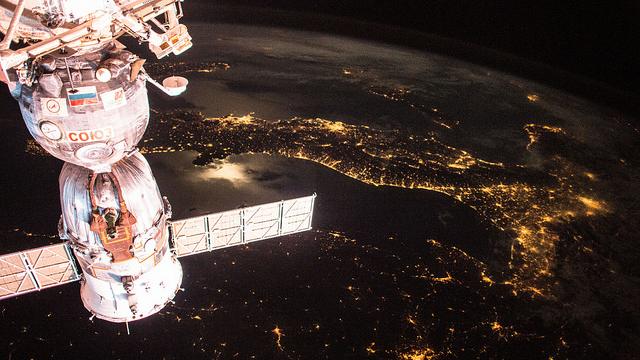Overnight, a piece of an old Russian-built weather satellite sped by dangerously close to the International Space Station. It’s the fourth time that astronauts aboard the ISS have “sheltered” because of space junk.
Picture: The Soyuz TMA-15M docked to the ISS in May; NASA
As NASA explained this morning in a short blog post about the move, the crew aboard the ISS were asked to take shelter in the Russian Soyuz vehicle currently docked on the station. NASA called the move “a precaution due to an anticipated close approach of a piece of space debris to the orbiting complex”, since these vehicles are the safest place to be in the event that the ISS is damaged.
Normally, the spacecraft would simply move out of the way of the debris if it had been spotted soon enough — though sheltering has taken place four times before, including in 2012 and 2011, but manoeuvring around debris is more common. Thankfully, the crew was given the all-clear minutes after the debris passed. But it’s another reminder that space junk is becoming more of a problem every year.
Mission Control gives #ISScrew “all clear” as orbital debris safely passes. http://t.co/2HV4bsKDOw … pic.twitter.com/wfbsely25F
— Intl. Space Station (@Space_Station) July 16, 2015
Explaining why we don’t yet have a system for clean up isn’t easy — it’s a mixture of complex technological and geopolitical issues. Last year, io9’s Mark Strauss talked to Theresa Hitchens, who directs the UN Institute for Disarmament Research, about the growing problem with space debris. Hitchens gave us a glimpse into the incredibly complicated world of space junk removal — which involves not only massive resource investment, but delicate political issues, sticky space laws, and the possibility that a space debris removal system could have a dual-use as a satellite-destroying weapon:
In a future era where everyone is armed to the teeth with anti-satellite capabilities, the likelihood of a debris strike being mistaken as a deliberate strike by an enemy skyrockets. It would be a very unstable situation, prone to miscalculation and crisis escalation. In my humble opinion, this is why the development and deployment of overt anti-satellite weapons systems would be a mistake.
In fact, earlier this month we got an update from the Swiss École polytechnique fédérale de Lausanne’s Center for Space Engineering, which is developing a satellite specifically to remove an existing Swiss satellite currently in orbit.
Called CleanSpace One, the hoover-sat is designed to use a net to capture the existing satellite and bring it down into the Earth’s atmosphere to destroy it. CleanSpace One is an ongoing project — the center estimates a 2018 launch — and there’s no guarantee it will work.
The danger from the debris passed earlier this morning, and everyone on the ISS is safe. But the efforts by Switzerland and national space agencies illustrate how difficult the task of cleaning up after yourself in space can be just as expensive and complex as getting there — and proof that the space debris problem isn’t going away anytime soon.
[NASA; h/t Wired.co.uk]
